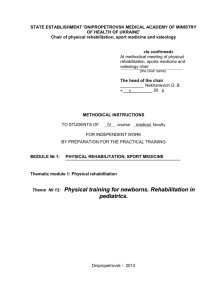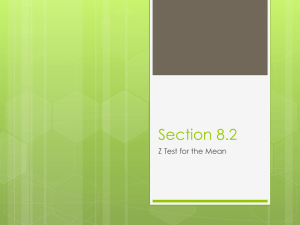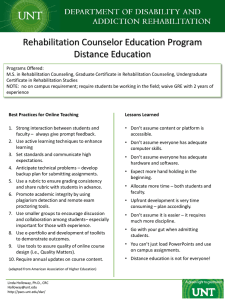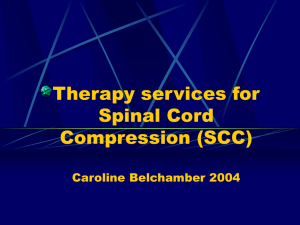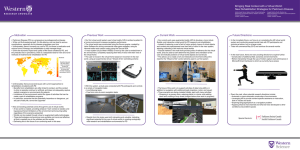pr 10 trauma
advertisement
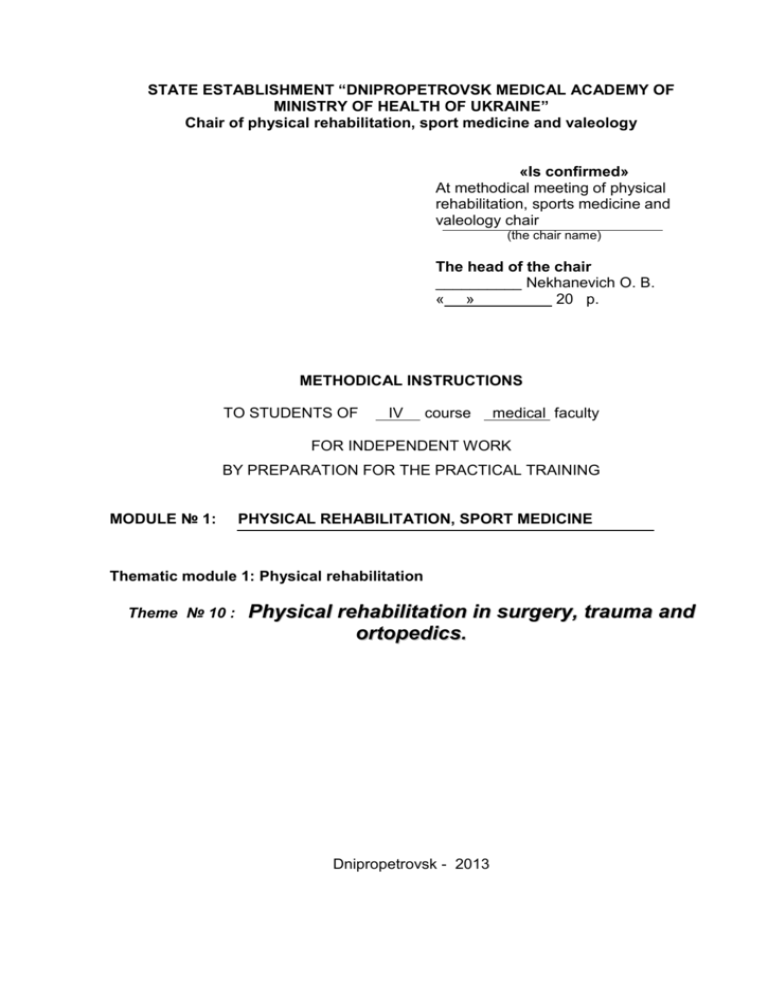
STATE ESTABLISHMENT “DNIPROPETROVSK MEDICAL ACADEMY OF MINISTRY OF HEALTH OF UKRAINE” Chair of physical rehabilitation, sport medicine and valeology «Is confirmed» At methodical meeting of physical rehabilitation, sports medicine and valeology chair (the chair name) The head of the chair __________ Nekhanevich O. B. « » 20 р. METHODICAL INSTRUCTIONS TO STUDENTS OF ІV course medical faculty FOR INDEPENDENT WORK BY PREPARATION FOR THE PRACTICAL TRAINING MODULE № 1: PHYSICAL REHABILITATION, SPORT MEDICINE Thematic module 1: Physical rehabilitation Theme № 10 : Physical rehabilitation in surgery, trauma and ortopedics. Dnipropetrovsk - 2013 MODULE І. PHYSICAL REHABILITATION, SPORT MEDICINE Thematic module 2: Physical rehabilitation Theme № 10 : Physical rehabilitation in surgery, trauma and orthopedics. 1. Theme urgency: There are a lot of surgical, traumatologic and orthopedics diseases and complications in Ukraine. Traumas are a common cause of death, complete or severe loss of working ability. Physical rehabilitation and manual therapy is as common the main method of treatment in these patients. Well time and adequate physical rehabilitation significantly enhances lost function recovery. 2. Theme duration: 2 hours. 3. The educational aim: To study physical rehabilitation methods as a part of complex therapy in surgical, traumatologic and orthopedics practice. Concrete aims: To know: - Indications and contraindications to physical rehabilitation in surgical, traumatologic and orthopedics diseases. - The aims and specialities of physical rehabilitation in case of fractures of bones. - PR in operations in chest and abdomen. - PR in scoliosis. - Indications and contraindications to PR in oseochondrosis. - PR in spine trauma. - PR in arthrosis. To be able: - To estimate the beginning level of functional state of an organism; To estimate the physical development and working capacity specialities; To evaluate clinical and lab data; To choose the correct rehabilitation; Monitor the rehabilitation proses; Make clinical interpretation and conclusion on treatment. To develop practical skills: - Self-holding antropometric study of patient. Self-holding functional state estimation. Correctly choose the physical rehabilitation methods; Make the monitoring of physical rehabilitation; Work with medical documents. 4. Basic knowledge, skills (interdisciplinary integration) – (table 4.1): Table 4.1 The names of previous disciplines Normal physiology Practical skills To be able to registrate main physiologic features, to know the loading test methodic. Propedeutics of internal disease To define the development process of prepathologic and pathologic organic changes, non-adequate physical exertion impact To take blood pressure, heart rate, describe pulsus. To be able to take electrocardiography, to hold the loading test. To evaluate the medical data. Pediatric Propedeutics To know the specifics of physical development in children according to different age. Pathologic physiology 5. Students advice. 5.1 Theoretic qestions: 1. Indications and contraindications for the purpose of physical rehabilitation in surgery. 2. Objectives and features DF methods in preoperative and postoperative periods at operative abdominal depending on motor mode and the postoperative period with a list of specific exercises. 3. Objectives and features DF methods in preoperative and postoperative periods in surgical interventions on the organs of the chest cavity, depending on the motor mode and the postoperative period with a list of specific exercises. 4. Indications and contraindications for use of FY injuries of the musculoskeletal system. 5. Objectives and methods of physical rehabilitation, depending on the period (immobilization, postimmobilizatsiynyy, recovery) and treatment. Justification of the choice of means and forms of FR. 6. Features separate methods gymnastics at diaphyseal fractures of the upper and lower extremities, articular fractures and dislocations, compression fractures of the spine and pelvis fractures. 7. Evaluating the effectiveness of physical rehabilitation in trauma patients. 5.2 Practical part: 1. describe Harvard step-test methodic and result evaluation. 2. describe Kuper test methodic and result evaluation 3. Describe the estimation of glicolitic, Oxidative-glicolitic and oxidativecapacity in human musculs. 4. Calculate the maximal oxygen consumption factor by PWC170 value. 5.4. Theme content: 5.3 Self-control materials: 1) self-control questions: 1. Indications and contraindications for the purpose of physical rehabilitation in surgery. 2. Objectives and features DF methods in preoperative and postoperative periods at operative abdominal depending on motor mode and the postoperative period with a list of specific exercises. 3. Objectives and features DF methods in preoperative and postoperative periods in surgical interventions on the organs of the chest cavity, depending on the motor mode and the postoperative period with a list of specific exercises. 4. Indications and contraindications for use of FY injuries of the musculoskeletal system. 5. Objectives and methods of physical rehabilitation, depending on the period (immobilization, postimmobilization, recovery) and treatment. Justification of the choice of means and forms of FR. 6. Features separate methods gymnastics at diaphyseal fractures of the upper and lower extremities, articular fractures and dislocations, compression fractures of the spine and pelvis fractures. 7. Evaluating the effectiveness of physical rehabilitation in trauma patients. 2) Тests: 1) Contradictions for exercise therapy in abdominal surgery are: A.* Heavy condition of a patient, hemorrhage risk, B. Disthony of urinary bladder, C. Increase of body temperature up to 37.50 0С, D. Bowels paresis, E. Insignificant pain syndrome. 2) Contradictions for prescribing exercise therapy in traumatology are all of the following except for one: A. Increase of erythrocyte sedimentation rate up to 20 mm/hour, B. Presence of the manifested pain syndrome. C. Threat of repeated hemorrhages, acute respiratory processes, D. Increase of body temperature over 38.0 0С, severe condition of a patient, E. Presence of foreign bodies near major vessels and nerve trunks. literature: the main 1. Remedial gymnastics and sport medicine: textbook/ Klapchuk V.V., Dsiak G.V., Mutavov V.I.; red. Klapchuk V.V., Dsiak G.V. – К.: Zdorov`e, 1995. – 312 p. 2. Remedial gymnastics and sport medicine: Tests for knowlage control in students of medical and stomatological faculties of universitie ІУ level of acreditation / Abramov В.В., Klapchuk В.В., Magl`ovanuy А.V., Smirnova О.L.,; red. Ph. Klapchuk V.V., Ph. Magl`ovanuy А.V. – Dnipropetrovsk: medical academy, 2006. – 124 p. 3. Remedial gymnastics and sport medicine (Lections) / Abramov В.В., Klapchuk V.V Smirnova О.L.,.; red. Ph. Klapchuk V.V.,– Dnipropetrovsk: medical academy, 2006. – 179 p 4. Medical control in physical training and sports: medical recommendations for students of medical and stomatological faculties of universitie ІУ level of acreditation / V.S. Sokolovskyy, N.А. Romanova, V.S. Vladova, I.I. Bondarev. – Odessa: osmu, 2001. – 93p. 5. Sport medicine. textbook / Makarova G.А. – М.: Soviet sport, 2003. – 480 p. 6. Textbook «Remedial gymnastics and medical control» red. Epifanova and G. L. Apanasenko – p.14-16, 25-37. 7. Functional tests in sport medicine (methodical recomendations) /Mychaluk E. L. –Kyiv. –2005. – 37p. Discussed on cathedral meeting «____»___________20___р. (Protocol № ____) The head of the cathedra, Phd. _________________ О.B.Nekhanevich Discussed on cathedral meeting «____»___________20___р. (Protocol № ____) The head of the cathedra, Phd. _________________ О.B.Nekhanevich
